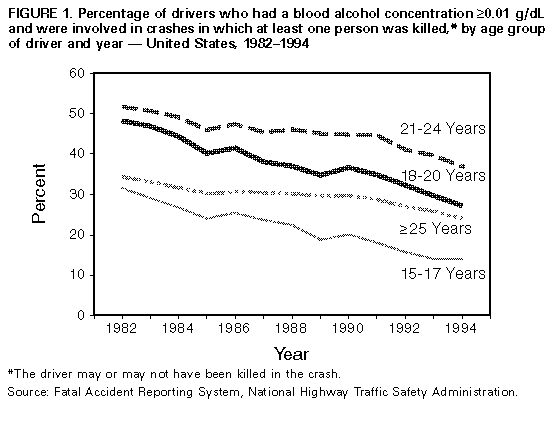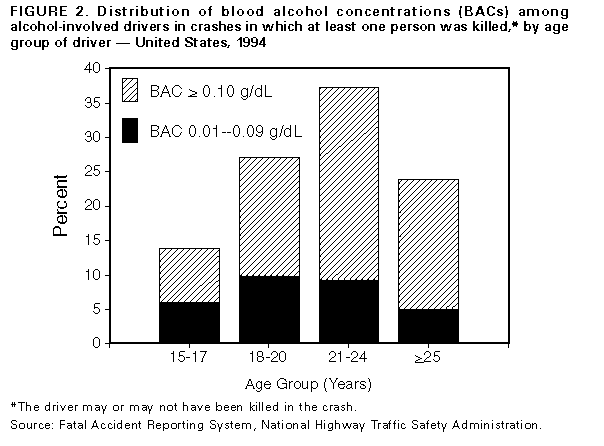 |
|
|
|
|
|
|
|
|
|
|
|
|
|
|
|
|
||||
| ||||||||||
|
|
|
|
Update: Alcohol-Related Traffic Crashes and Fatalities Among Youth and Young Adults -- United States, 1982-1994Approximately one third of deaths among persons aged 15-24 years result from motor-vehicle crashes (1). Although alcohol use increases the risk for motor-vehicle crashes for all drivers, for young drivers the risk begins to increase at very low blood alcohol concentrations (BACs) (2). In addition, in young persons who drive after drinking, the relative risk for crash involvement is greater at all BACs than for older drivers who drink (3). This report is based on data from the Fatal Accident Reporting System of the National Highway Traffic Safety Administration (NHTSA) and describes trends in alcohol involvement among drivers in fatal traffic crashes and trends in all alcohol-related traffic fatalities (ARTFs) in the United States from 1982 through 1994 among youth and young adults. NHTSA refers to drivers with a BAC greater than or equal to 0.01 g/dL in a police-reported traffic crash as alcohol-involved; drivers with a BAC greater than or equal to 0.10 g/dL (the legal level of intoxication in most states) are considered intoxicated. NHTSA considers a fatal traffic crash to be alcohol-related if either a driver or nonoccupant (e.g., pedestrian) had a BAC greater than or equal to 0.01 g/dL in a police-reported traffic crash. Because BACs are not available for all persons involved in fatal crashes, NHTSA estimates the number of ARTFs based on a discriminant analysis of information from all cases for which driver or nonoccupant BAC data are available (4). Statistics about drivers refer only to drivers involved in fatal crashes; the driver may or may not have been killed in the crash. Data are presented for youth (persons aged 15-17 years and 18-20 years), young adults (21-24 years), and other adults (greater than or equal to 25 years). During 1982-1994, the estimated percentage and total number of alcohol-involved drivers in fatal crashes (i.e., crashes in which at least one person was killed) decreased for all four age groups Table_1. Decreases in the proportion of alcohol-involved drivers were greater for persons aged 15-17 years (56%) and 18-20 years (44%) than for persons aged 21-24 years (28%) and greater than or equal to 25 years (30%). However, the proportion of alcohol-involved drivers aged 18-20 years was higher than the proportion of alcohol-involved drivers aged greater than or equal to 25 years each year from 1982 through 1994 Figure_1. In addition, following the rapid decline from 1982 through 1989 in the proportion of alcohol-involved drivers aged 15-17 years, the proportion declined more slowly from 1990 through 1994 Figure_1. In 1994, the percentage of alcohol-involved drivers in fatal crashes who were intoxicated increased with age: of persons aged 15-17 years who were alcohol-involved drivers in fatal crashes, 57% were intoxicated, compared with 64% of persons aged 18-20 years, 75% of persons aged 21-24 years, and 79% of persons aged greater than or equal to 25 years Figure_2. Reported by: JB Wright, Office of Alcohol and State Programs, Traffic Safety Programs, National Highway Traffic Safety Administration. Div of Unintentional Injury Prevention, National Center for Injury Prevention and Control, CDC. Editorial NoteEditorial Note: The findings in this report document that the overall decline in alcohol involvement among drivers in fatal crashes during 1982-1989 (5) continued through 1994. However, a substantial proportion of young drivers in fatal crashes had a BAC greater than or equal to 0.01 g/dL. The decline in alcohol involvement among drivers is consistent with the decline in the number and percentage of all ARTFs in the United States during 1982-1994 Table_2. However, in 1994, 29% of crash-related deaths among persons aged 15-17 years and 44% of those among persons aged 18-20 years were alcohol-related. In addition, the prevalence of drinking and driving increases substantially among youth and young adults with the frequency of alcohol use and is strongly associated with binge drinking (1,6). These findings highlight the need for additional prevention measures targeted specifically to young drivers. Factors that may have contributed to the decline in both impaired driving and total ARTFs among young persons include prompt license suspension for persons who drive while intoxicated; increasing the minimum drinking age (since 1988, the minimum drinking age has been 21 years in all states); and the initiation of public education, community awareness, and media campaigns about the dangers of alcohol-involved driving (7). NHTSA efforts to prevent alcohol-involved driving among youth and young adults include supporting enforcement of minimum drinking age laws; providing grants to states to implement graduated licensing systems that both allow new drivers to accumulate driving experience in low-risk settings and gradually relax restrictions until an unrestricted license is earned (8); reducing legally permissible BACs to 0.08 g/dL for drivers aged greater than or equal to 21 years; promoting "zero-tolerance" laws, which lowers the legal BAC for drivers aged less than 21 years *; and developing workshops for judges and police officials to address the special problems associated with alcohol-related offenses among youth. CDC is evaluating the effectiveness of mandatory substance-abuse assessment and treatment to reduce the risk for repeat arrests for driving while impaired among drivers of all ages and the effectiveness of intervention strategies to reduce both alcohol intake and future alcohol-related injuries among young adults hospitalized for motor-vehicle-crash-related injuries. Although additional efforts are necessary to evaluate the effectiveness of interventions to prevent alcohol-impaired driving, the findings in this report indicate the need for intensified measures -- including stronger state legislation (e.g., zero-tolerance laws) -- to prevent ARTFs among youth and young adults. References
Figure_1  Return to top. Table_1 Note: To print large tables and graphs users may have to change their printer settings to landscape and use a small font size.
TABLE 1. Estimated number of total drivers* and estimated number and percentage of alcohol-involved drivers * in
crashes in which at least one person was killed, + by year and age group of driver -- United States, 1982-1994
======================================================================================================================
Age group
--------------------------------------------------------------------------------------------------------
15-17 years 18-20 years 21-24 years >=25 years
------------------------- ------------------------- ------------------------- -------------------------------
Alcohol-involved Alcohol-involved Alcohol-involved Alcohol-involved
Total ---------------- Total ---------------- Total ---------------- Total ----------------
Year drivers No. (%) drivers No. (%) drivers No. (%) drivers No. (%)
----------------------------------------------------------------------------------------------------------------------
1982 2,892 909 (31.5) 7,188 3,468 (48.2) 9,018 4,646 (51.6) 35,586 12,168 (34.2)
1983 2,840 825 (29.1) 6,707 3,141 (46.8) 8,432 4,269 (50.7) 35,418 11,723 (33.1)
1984 2,989 799 (26.7) 7,057 3,128 (44.3) 8,963 4,393 (49.0) 37,255 11,742 (31.5)
1985 3,063 734 (23.9) 6,596 2,652 (40.2) 9,046 4,156 (45.9) 37,890 11,452 (30.2)
1986 3,583 910 (25.4) 6,887 2,850 (41.4) 9,129 4,313 (47.3) 39,396 12,008 (30.5)
1987 3,606 853 (23.7) 6,587 2,508 (38.1) 8,808 4,004 (45.4) 41,111 12,457 (30.3)
1988 3,472 776 (22.4) 6,943 2,562 (36.9) 8,555 3,935 (46.1) 41,932 12,625 (30.1)
1989 3,134 589 (18.7) 6,537 2,269 (34.7) 7,723 3,475 (45.0) 41,705 12,270 (29.5)
1990 2,882 577 (20.1) 6,170 2,255 (36.6) 7,195 3,230 (44.8) 41,377 12,297 (29.7)
1991 2,650 479 (18.1) 5,570 1,938 (34.8) 6,748 3,003 (44.5) 38,257 10,985 (28.7)
1992 2,644 416 (15.7) 4,759 1,536 (32.2) 6,323 2,594 (41.0) 37,167 10,057 (27.0)
1993 2,654 373 (14.1) 4,830 1,431 (29.6) 6,406 2,527 (39.5) 38,418 9,842 (25.7)
1994 2,910 403 (13.9) 5,047 1,369 (27.1) 6,280 2,346 (37.3) 39,184 9,345 (23.9)
----------------------------------------------------------------------------------------------------------------------
* Drivers with a blood alcohol concentration >=0.01 g/dL.
+ The driver may or may not have been killed in the crash.
Source: Fatal Accident Reporting System, National Highway Traffic Safety Administration.
======================================================================================================================
Return to top. Figure_2  Return to top. Table_2 Note: To print large tables and graphs users may have to change their printer settings to landscape and use a small font size.
TABLE 2. Estimated number of total traffic fatalities * and estimated number and percentage of alcohol-related traffic
fatalities +, by year and age group -- United States, 1982-1994
==========================================================================================================================
Age group
--------------------------------------------------------------------------------------------------------------------
15-17 years 18-20 years 21-24 years >=25 years
---------------------------- ---------------------------- ---------------------------- -----------------------------
Alcohol-related Alcohol-related Alcohol-related Alcohol-related
Total ---------------- Total ----------------- Total ---------------- Total -----------------
Year fatalities No. (%) fatalities No. (%) fatalities No. (%) fatalities No. (%)
--------------------------------------------------------------------------------------------------------------------------
1982 2,906 1,556 (53.6) 5,602 3,824 (68.2) 6,404 4,593 (71.7) 25,607 14,093 (55.0)
1983 2,748 1,343 (48.8) 5,166 3,405 (65.9) 6,020 4,330 (71.9) 25,378 13,576 (53.5)
1984 2,869 1,354 (47.1) 5,232 3,364 (64.3) 6,293 4,398 (69.9) 26,566 13,675 (51.5)
1985 2,834 1,270 (44.8) 4,829 2,914 (60.3) 6,187 4,182 (67.6) 26,593 13,400 (50.4)
1986 3,399 1,515 (44.6) 5,154 3,127 (60.6) 6,262 4,308 (68.8) 27,863 14,126 (50.7)
1987 3,322 1,400 (42.1) 4,891 2,811 (57.4) 5,917 3,937 (66.5) 28,861 14,563 (50.5)
1988 3,082 1,240 (40.2) 5,200 2,947 (56.7) 5,866 3,936 (67.1) 29,495 14,571 (49.4)
1989 2,797 1,028 (36.8) 4,706 2,511 (53.4) 5,184 3,454 (66.6) 29,578 14,522 (49.2)
1990 2,744 1,027 (37.4) 4,564 2,532 (55.5) 5,049 3,298 (65.3) 29,239 14,448 (49.4)
1991 2,468 833 (33.8) 4,175 2,273 (54.4) 4,782 3,138 (65.6) 27,189 12,908 (47.5)
1992 2,405 750 (31.2) 3,445 1,727 (50.1) 4,298 2,655 (61.8) 26,333 12,044 (45.7)
1993 2,416 708 (29.4) 3,495 1,649 (47.2) 4,400 2,612 (59.4) 26,950 11,782 (43.7)
1994 2,610 752 (28.8) 3,616 1,590 (44.0) 4,229 2,351 (55.6) 27,224 11,225 (41.2)
--------------------------------------------------------------------------------------------------------------------------
* Driver or nonoccupant.
+ Crash-related deaths in which either a driver or nonoccupant (e.g., pedestrian) had a blood alcohol concentration >=0.01
g/dL in a police-reported crash.
Source: Fatal Accident Reporting System, National Highway Traffic Safety Administration.
==========================================================================================================================
Return to top. Disclaimer All MMWR HTML versions of articles are electronic conversions from ASCII text into HTML. This conversion may have resulted in character translation or format errors in the HTML version. Users should not rely on this HTML document, but are referred to the electronic PDF version and/or the original MMWR paper copy for the official text, figures, and tables. An original paper copy of this issue can be obtained from the Superintendent of Documents, U.S. Government Printing Office (GPO), Washington, DC 20402-9371; telephone: (202) 512-1800. Contact GPO for current prices. **Questions or messages regarding errors in formatting should be addressed to mmwrq@cdc.gov.Page converted: 09/19/98 |
|||||||||
This page last reviewed 5/2/01
|